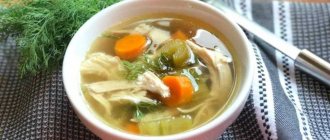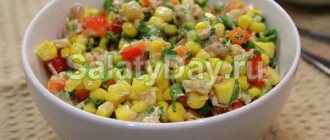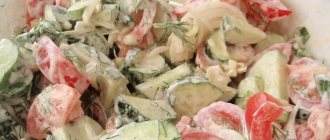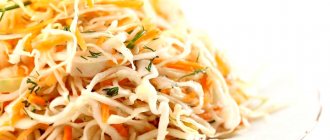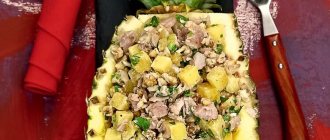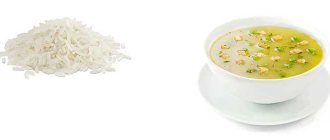Properties of curry
Nutritional value and composition | Vitamins | Minerals
How much does curry cost (average price for 1 kg)?
Moscow and Moscow region.
400 rub.
Currently, herbs and spices have become very popular in our cooking. It’s hard to imagine a kitchen without a whole scattering of colorful little bags, fragrant with completely different aromas. In Russia, one of the favorite seasonings of housewives is curry - a mixture of different spices. It comes from India and most often contains spices such as turmeric, cardamom, coriander, ginger, black and red pepper.
The curry mixture goes well with almost any dish. For example, in India, housewives put this spice in meat and fish dishes, vegetables and rice. It is even used in baked goods and drinks. Moreover, thanks to curry, dishes acquire a beautiful golden hue and an unforgettable aroma.
Vegetable stew, chicken salads, vinaigrette, meatballs, beef stroganoff... our housewives find the most unexpected uses for this spice. Be sure to add curry to your arsenal of seasonings, you will be amazed at the incredible flavor it will add to your culinary masterpieces! The calorie content of curry is 325 kcal per 100 grams of spice.
Curry sauce
For many people, not only the taste of food is very important, but also the amount of calories it contains. Those people who carefully monitor their figure know very well that usually an excess of calories causes an increase in fat deposits in the human body, and sometimes some other health problems. Many doctors and well-known publications recommend assessing the calorie content of the foods that we regularly eat during dinner, and when this figure exceeds the norm, it is highly recommended to completely change your diet and remove all of these foods from your diet.
The calorie content of food products is often present on food packaging, on labels, on special shelves in restaurants; these numbers are quite easy to find out; this information is considered public, for example, in specialized publications it is shown in the form of large tables. Also, we must remember that the number of calories in food products depends on the method of determining this characteristic. Different food manufacturers define calorie content in different ways, so do not be surprised if you read different calorie content values on boxes of the same food products from different manufacturers.
Particular attention should be paid to alcohol. Actually, alcohol contains quite a lot of calories and this nuance should be remembered; it is necessary to completely eliminate alcohol from the menu, but not everyone is ready for such a turn.
If you want to see the calorie content of foods, go to a special filter.
If you count the calorie content of food products every day, using voluminous tables, you will have to spend a lot of effort, in addition, you must remember that the calorie content of some dishes prepared by you personally is not included in these tables; in addition, this method of calculation has long been considered outdated.
For the purpose of quick and convenient analysis of calorie content, a special program is used - an online calorie calculator. This application simply indicates the mass of foods consumed or certain dishes, and the application tells how many calories are in the food eaten, and you can also find out not only the number of kilocalories, but also proteins, fats and carbohydrates for various types of meals (afternoon snack, lunch, dinner ). Separately, it should be noted that the application has the ability to calculate the corresponding characteristics of your own recipes that are made at home. It is also possible to attach a recipe to your prepared dish in the form of text, so that in the future you will be able to return to it and cook your dish again, for example, for your friends. Any food products in the application are placed in the form of a list indicating: the number of calories, the volume of fats, polypeptides and carbohydrates, the glycemic index of foods and the glycemic load. It is possible to quickly sort the desired food products using a special sorting system. By simply pressing a key, you can select food products of only the class you need.
Benefits of curry
The benefits of curry when eaten are undeniable, since this mixture is simply designed to maintain the correct balance in the functioning of all systems of the human body. Curry improves liver function, promotes the digestion process, and removes harmful toxins and waste.
The benefits of curry as a dietary product are known, since turmeric, which is part of the spice, is the main “enemy” of fat. This is justified by the fact that the component curcumin prevents the growth of adipose tissue by slowing down the metabolism of unwanted cells. Another important feature of this substance is its ability to activate the immune system, as well as destroy proteins that block brain activity and thereby contribute to the development of the terrible Alzheimer’s disease.
You should take into account the fact that the properties of curry directly depend on the specific composition of the spice. For example, black pepper, which is part of the spice, is useful for diabetes, and cumin and ginger perfectly improve the functioning of the digestive system. It has been established that coriander stimulates appetite and normalizes bile secretion.
In general, if you are not entirely satisfied with the composition of the finished spice, which can be found in almost any supermarket, you can prepare it yourself by mixing the ingredients you like most.
Beneficial features
Curry is definitely a very healthy product. This is understandable: the mixture contains several spices, each of which is valuable for the human body and has a number of medicinal properties. It is known that the spice helps keep the skin young and also successfully fights various bacteria. Let's take a closer look at each ingredient that makes up the curry.
- Coriander. Its seeds, first of all, have a good effect on the entire digestive system. Thanks to coriander grains, food is digested much better, processes in the intestines are improved, and the seeds also provide an excellent choleretic effect.
- Fenugreek (fenugreek, shamballa). The product obtained from fenugreek fruits helps improve appetite and successfully fights inflammatory processes, especially those associated with skin diseases and pulmonary diseases.
- Lastly, turmeric. The substance curcumin contained in it helps in the fight against Alzheimer's disease, and also has an antitumor effect (including used in the treatment of cancer), cleanses the blood of harmful substances and removes toxins from the body.
- Ginger. Useful for constipation, has a beneficial effect on the immune system.
Contraindications
It is not recommended to consume curry for young children (under 2-3 years old), as well as for pregnant and lactating women.
Calorie content of Curry. Chemical composition and nutritional value.
Nutritional value and chemical composition of "Curry".
The table shows the nutritional content (calories, proteins, fats, carbohydrates, vitamins and minerals) per 100 grams of edible portion.
| Nutrient | Quantity | Norm** | % of the norm in 100 g | % of the norm in 100 kcal | 100% normal |
| Calorie content | 325 kcal | 1684 kcal | 19.3% | 5.9% | 518 g |
| Squirrels | 14.29 g | 76 g | 18.8% | 5.8% | 532 g |
| Fats | 14.01 | 56 g | 25% | 7.7% | 400 g |
| Carbohydrates | 2.63 g | 219 g | 1.2% | 0.4% | 8327 g |
| Alimentary fiber | 53.2 g | 20 g | 266% | 81.8% | 38 g |
| Water | 8.8 g | 2273 g | 0.4% | 0.1% | 25830 g |
| Ash | 7.07 g | ~ | |||
| Vitamins | |||||
| Vitamin A, RE | 1 mcg | 900 mcg | 0.1% | 90000 g | |
| beta carotene | 0.011 mg | 5 mg | 0.2% | 0.1% | 45455 g |
| Vitamin B1, thiamine | 0.176 mg | 1.5 mg | 11.7% | 3.6% | 852 g |
| Vitamin B2, riboflavin | 0.2 mg | 1.8 mg | 11.1% | 3.4% | 900 g |
| Vitamin B4, choline | 64.2 mg | 500 mg | 12.8% | 3.9% | 779 g |
| Vitamin B5, pantothenic | 1.07 mg | 5 mg | 21.4% | 6.6% | 467 g |
| Vitamin B6, pyridoxine | 0.105 mg | 2 mg | 5.3% | 1.6% | 1905 |
| Vitamin B9, folates | 56 mcg | 400 mcg | 14% | 4.3% | 714 g |
| Vitamin C, ascorbic acid | 0.7 mg | 90 mg | 0.8% | 0.2% | 12857 g |
| Vitamin E, alpha tocopherol, TE | 25.24 mg | 15 mg | 168.3% | 51.8% | 59 g |
| gamma tocopherol | 1.15 mg | ~ | |||
| Vitamin K, phylloquinone | 99.8 mcg | 120 mcg | 83.2% | 25.6% | 120 g |
| Vitamin RR, NE | 3.26 mg | 20 mg | 16.3% | 5% | 613 g |
| Betaine | 28.8 mg | ~ | |||
| Macronutrients | |||||
| Potassium, K | 1170 mg | 2500 mg | 46.8% | 14.4% | 214 g |
| Calcium, Ca | 525 mg | 1000 mg | 52.5% | 16.2% | 190 g |
| Magnesium, Mg | 255 mg | 400 mg | 63.8% | 19.6% | 157 g |
| Sodium, Na | 52 mg | 1300 mg | 4% | 1.2% | 2500 g |
| Sera, S | 142.9 mg | 1000 mg | 14.3% | 4.4% | 700 g |
| Phosphorus, Ph | 367 mg | 800 mg | 45.9% | 14.1% | 218 g |
| Microelements | |||||
| Iron, Fe | 19.1 mg | 18 mg | 106.1% | 32.6% | 94 g |
| Manganese, Mn | 8.3 mg | 2 mg | 415% | 127.7% | 24 g |
| Copper, Cu | 1200 mcg | 1000 mcg | 120% | 36.9% | 83 g |
| Selenium, Se | 40.3 mcg | 55 mcg | 73.3% | 22.6% | 136 g |
| Zinc, Zn | 4.7 mg | 12 mg | 39.2% | 12.1% | 255 g |
| Digestible carbohydrates | |||||
| Mono- and disaccharides (sugars) | 2.76 g | max 100 g | |||
| Galactose | 0.21 g | ~ | |||
| Glucose (dextrose) | 1.14 g | ~ | |||
| Sucrose | 0.62 g | ~ | |||
| Fructose | 0.79 g | ~ | |||
| My | |||||
| My nutrient 1 | 48504 | ~ | |||
| My nutrient 2 | 1075 | ~ | |||
| Essential amino acids | |||||
| Arginine* | 0.89 g | ~ | |||
| Valin | 0.75 g | ~ | |||
| Histidine* | 0.29 g | ~ | |||
| Isoleucine | 0.63 g | ~ | |||
| Leucine | 0.89 g | ~ | |||
| Lysine | 0.7 g | ~ | |||
| Methionine | 0.19 g | ~ | |||
| Threonine | 0.35 g | ~ | |||
| Tryptophan | 0.11 g | ~ | |||
| Phenylalanine | 0.58 g | ~ | |||
| Nonessential amino acids | |||||
| Alanin | 0.55 g | ~ | |||
| Aspartic acid | 1.79 g | ~ | |||
| Glycine | 0.79 g | ~ | |||
| Glutamic acid | 2.27 g | ~ | |||
| Proline | 1.24 g | ~ | |||
| Serin | 0.39 g | ~ | |||
| Tyrosine | 0.4 g | ~ | |||
| Cysteine | 0.2 g | ~ | |||
| Saturated fatty acids | |||||
| Saturated fatty acids | 1.648 g | max 18.7 g | |||
| 4:0 Oil | 0.012 g | ~ | |||
| 6:0 Kapronovaya | 0.038 g | ~ | |||
| 8:0 Caprylic | 0.013 g | ~ | |||
| 10:0 Kaprinovaya | 0.013 g | ~ | |||
| 13:0 Tridecane | 0.079 g | ~ | |||
| 14:0 Miristinovaya | 0.637 g | ~ | |||
| 16:0 Palmitinaya | 0.681 g | ~ | |||
| 18:0 Stearic | 0.174 g | ~ | |||
| Monounsaturated fatty acids | 8.782 g | min 16.8 g | 52.3% | 16.1% | |
| 16:1 Palmitoleic | 0.013 g | ~ | |||
| 18:1 Oleic (omega-9) | 8.742 g | ~ | |||
| 18:1 cis | 8.742 g | ~ | |||
| 20:1 Gadoleic (omega-9) | 0.013 g | ~ | |||
| 22:1 Erucic (omega-9) | 0.014 g | ~ | |||
| Polyunsaturated fatty acids | 3.056 g | from 11.2 to 20.6 g | 27.3% | 8.4% | |
| 18:2 Linolevaya | 2.788 g | ~ | |||
| 18:3 Linolenic | 0.268 g | ~ | |||
| 18:3 Omega-3, alpha-linolenic | 0.255 g | ~ | |||
| 18:3 Omega-6, gamma-linolenic | 0.013 g | ~ | |||
| Omega-3 fatty acids | 0.255 g | from 0.9 to 3.7 g | 28.3% | 8.7% | |
| Omega-6 fatty acids | 2.801 g | from 4.7 to 16.8 g | 59.6% | 18.3% |
The energy value of Curry is 325 kcal.
Primary Source: Created in the application by the user. Read more.
** This table shows the average levels of vitamins and minerals for an adult. If you want to know the norms taking into account your gender, age and other factors, then use the “My Healthy Diet” application.
Preparation
- Place the chicken breast in a large, deep saucepan. Add cold water a few inches above the chicken.
- Add onion, pepper, cloves and bay leaf.
- Bring to a boil. Reduce heat and simmer for another 10–14 minutes until fully cooked.
- Check the readiness of the product with a knife, make sure there is no pink color.
- Cut the chicken into small cubes. Place in the refrigerator while you prepare the sauce.
- Heat oil in a small skillet over medium heat. Add the onion and fry for 4-5 minutes in the oil until soft (don't let it brown).
- Add curry powder and simmer for one minute until you can smell the spice. Remove from heat and let cool to room temperature.
- When the mixture has cooled, combine it with mayonnaise, lime juice and salt in a separate small bowl.
- Combine chicken with curry sauce and add salt to taste.
The finished sauce must be stored only in the refrigerator and for no more than 3 days.
Your chicken curry salad is ready! If desired, you can add pineapples, raisins and even bananas.

